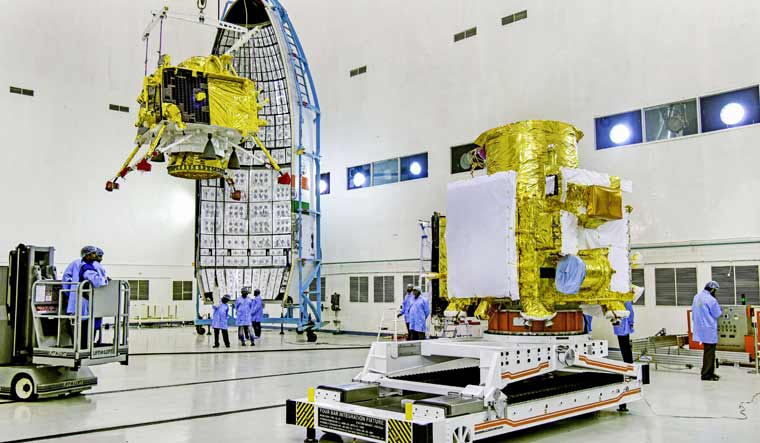ISRO announced it successfully separated its lander 'Vikram' from Chandrayaan-2 Orbiter at 1315 IST on Monday. It had, on Sunday, successfully performed the fifth and final lunar bound orbit manoeuvre; the separation was the next step in the process.
"The final and fifth Lunar bound orbit manoeuvre for Chandrayaan-2 spacecraft was performed successfully on Sunday using the onboard propulsion system. The duration of the manoeuvre was 52 seconds. The orbit achieved is 119 km x 127 km," ISRO had said in an update.
ALSO READ
- Chandrayaan-2: Hope dims for Vikram lander as lunar day ends
- Moon mission would be successful on 'Ekadashi' day, claims Hindutva leader
- Chinese netizens praise Chandrayaan-2, ask scientists not to lose hope
- ISRO locates Vikram lander intact, but tilted on lunar surface
- Location of lander proves orbiter functioning well: Expert
- Chandrayaan-2: Vikram traced, but re-establishing communication 'less probable'
- Chandrayaan 2: Difficult to establish link with lander, says ISRO official
Following this, there would be two de-orbit manoeuvres of lander 'Vikram' to prepare for its landing in the south polar region of the moon.
Vikram (with rover 'Pragyan' housed inside) is expected to touch down on the lunar surface on September 7, between 01.30am and 02.30am.
ISRO said that after the lander's separation on Monday, two de-orbit manoeuvres are scheduled for September 3 and September 4 respectively, before the powered decent on September 7.
ISRO Chairman K. Sivan has said the proposed soft-landing on the Moon would be a "terrifying" moment as it is something ISRO has not done before, whereas the Lunar Orbit Insertion manoeuvre was successfully carried out during the Chandrayaan-1 mission.
In a major milestone for India's second Moon mission, the Chandrayaan-2 spacecraft had successfully entered the lunar orbit on August 20 by performing the LOI maneuver.
Chandrayaan-2 satellite began its journey towards the moon,leaving the earth's orbit in the dark hours on August 14, after a crucial manoeuvre called Trans Lunar Insertion (TLI) carried out by ISRO to place the spacecraft on "Lunar Transfer Trajectory".
India's Geosynchronous Satellite Launch Vehicle, GSLV MkIII-M1 had successfully launched the 3,840-kg Chandrayaan-2 spacecraft into the earth's orbit on July 22.
The spacecraft's health is being continuously monitored from the Mission Operations Complex at ISRO Telemetry,Tracking and Command Network in Bengaluru with support from Indian Deep Space Network antennas at Bylalu, near Bengaluru, the space agency has said.
Following the landing, the rover 'Pragyan' will roll out from lander 'Vikram' between 5:30-6:30 am on September 7 and carry out experiments on the lunar surface for a period of one lunar day, which is equal to 14 earth days.
The mission life of the lander is also one lunar day, while the orbiter will continue its mission for a year. The orbiter carries eight scientific payloads for mapping the lunar surface and study the exosphere (outer atmosphere) of the Moon while the lander carries three scientific payloads to conduct surface and subsurface science experiments.
The rover carries two payloads to enhance the understanding of the lunar surface. India's second lunar expedition would shed light on a completely unexplored section of the Moon, its South Polar region.
ISRO has said that the mission objective of Chandrayaan-2 is to develop and demonstrate the key technologies for end-to-end lunar mission capability, including soft-landing and roving on the lunar surface.
On the science front, the mission aims to further expand the knowledge about the moon through a detailed study of its topography, mineralogy, surface chemical composition, thermo-physical characteristics and atmosphere, leading to a better understanding of the origin and evolution of the moon, the space agency had said.
-Inputs from PTI


